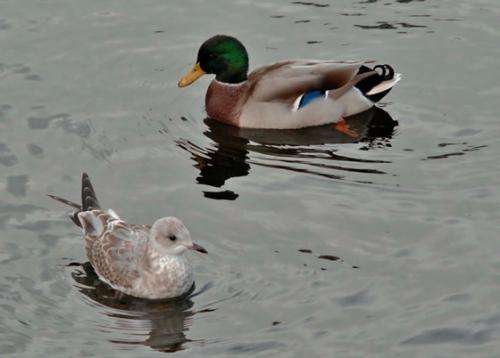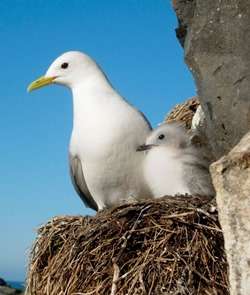Influenza virus in wild birds in Norway

Ducks and gulls are the natural hosts of influenza A virus. Ragnhild Tønnessen's PhD research project has characterised influenza A viruses in gulls and ducks in Norway.
Her discoveries may lead to a better understanding of the epidemiology and host adaptation of influenza A virus.
Wild birds, particularly ducks and gulls, are the natural hosts for influenza A viruses which can cause disease in animals and humans. Influenza A viruses can be divided into subtypes, of which the majority have been found in wild birds. Most subtypes of influenza A viruses cause subclinical infections in wild birds. Infections in domestic chickens most commonly result in mild disease. In rare cases, if introduced from wild birds to poultry, some viruses of the H5 and H7 subtypes mutate and become highly pathogenic. One example of this is the highly pathogenic H5N1 virus in Southeast Asia known to cause "bird flu".
Due to the outbreak of highly pathogenic avian influenza virus subtype H5N1 in Southeast Asia, a programme to monitor influenza viruses in wild birds in Norway was initiated in 2005. A large number of samples, gathered by hunters from ducks and gulls, were analysed at the Norwegian Veterinary Institute. Samples collected from Rogaland County in the South-West of Norway during the hunting seasons (August-December) of 2005-2007 and 2009-2010 were studied. The results showed that low pathogenic avian influenza viruses were present in 15.5% of the samples, and that the virus occurrence was higher in dabbling ducks than in gulls. The virus prevalence was lowest in December. Many different subtypes of the influenza A virus were detected, but not the highly pathogenic H5N1 virus.
Exchange of genes between influenza viruses from gulls and ducks
The complete genetic material from a total of five influenza viruses from mallard and common gull were sequenced and characterized. The results showed that the genes of the Norwegian viruses resembled the genes found in influenza viruses from other wild birds in Europe.
Due to limited overlap between the routes used by migratory birds in Eurasia and America, influenza viruses with different genetic material have developed between these two continents. However, in some areas, it has been observed that genes can be exchanged between influenza viruses from Eurasia and America. Tønnessen studied the role that gulls play in the transfer of virus genes between these two continents. Genes from American avian influenza viruses were not detected in the European gull viruses studied. However, within avian influenza viruses from Eurasia, she found that virus genes were exchanged between influenza typically found in gulls and ducks, respectively.

During the breeding seasons of 2008 and 2009, Tønnessen studied the occurrence of influenza virus in the black-legged kittiwake (Rissa tridactyla) at Hornøya in Finnmark in Northern Norway. Low amounts of influenza virus were detected in 5-15% of the samples from adult kittiwakes, and she discovered that more than 70% of the adult birds had developed antibodies against influenza A virus. The majority of the kittiwakes had antibodies against an influenza virus subtype typically found in gulls, namely H16.
Typical influenza viruses from gull can remain infective in water for a long time
Ducks can become infected with influenza virus through consumption of surface water contaminated with faeces shed by virus infected birds. Most subtypes of influenza virus from ducks can retain their infectivity in water over long periods of time. Experiments performed by Tønnessen showed that influenza virus subtypes primarily found in gulls (i.e. H13 and H16) can also remain infectious in water for several months under different salinity and temperature conditions.
To assess if a typical influenza virus subtype from gull can infect chickens, Tønnessen inoculated chickens with an H16N3 virus obtained from herring gull. Influenza virus was detected in the oropharynx of 2 of the 19 virus inoculated chickens, and specific antibodies against H16 were found in the same two chickens.The chickens did not become ill and the virus did not infect the contact chickens. These results suggest that H16N3 virus from gull can cause a limited infection in chickens.
In order to find out why influenza viruses of the H13 and H16 subtypes primarily infect gulls, Tønnessen examined whether the internal proteins of these viruses have particular signatures (amino acid composition) possibly related to host adaptation. Several signatures which can be related to host adaptation were detected, but their importance needs to be further evaluated in experimental studies.
Cand.med.vet. Ragnhild Tønnessen defended her doctoral research on 27th August 2013 at the Norwegian School of Veterinary Science with a thesis entitled "Epidemiology and Host Adaptation of Influenza A Viruses in Gulls".
The research was conducted at the Department of Food Safety and Infection Biology at the Norwegian School of Veterinary Science and at Section for Virology at the Norwegian Veterinary Institute.
Provided by Norwegian School of Veterinary Science
















